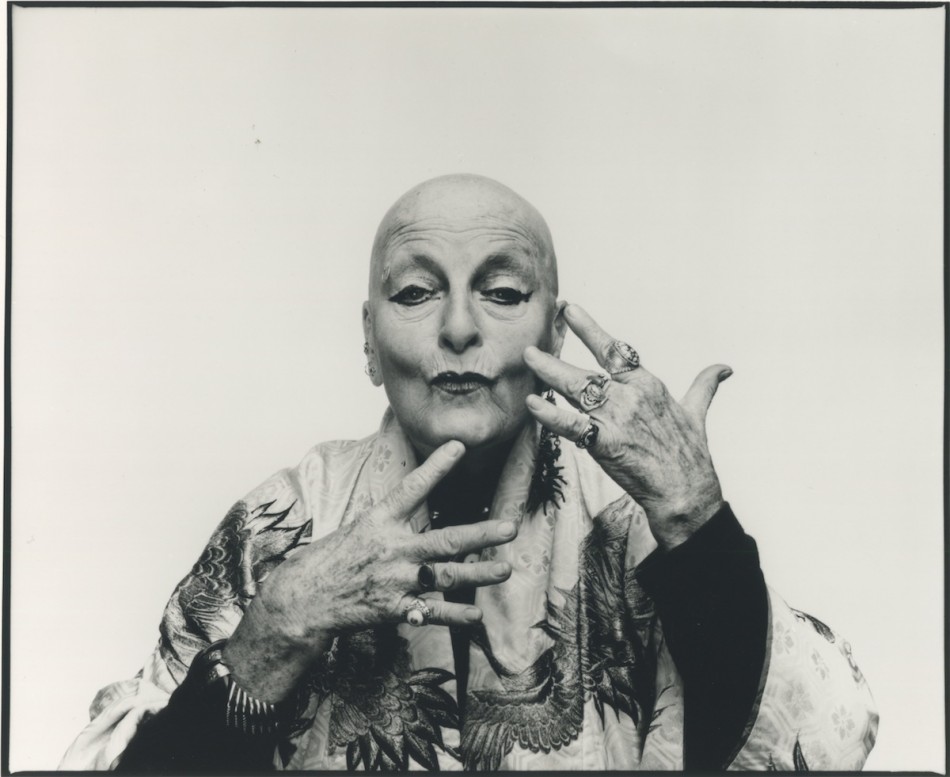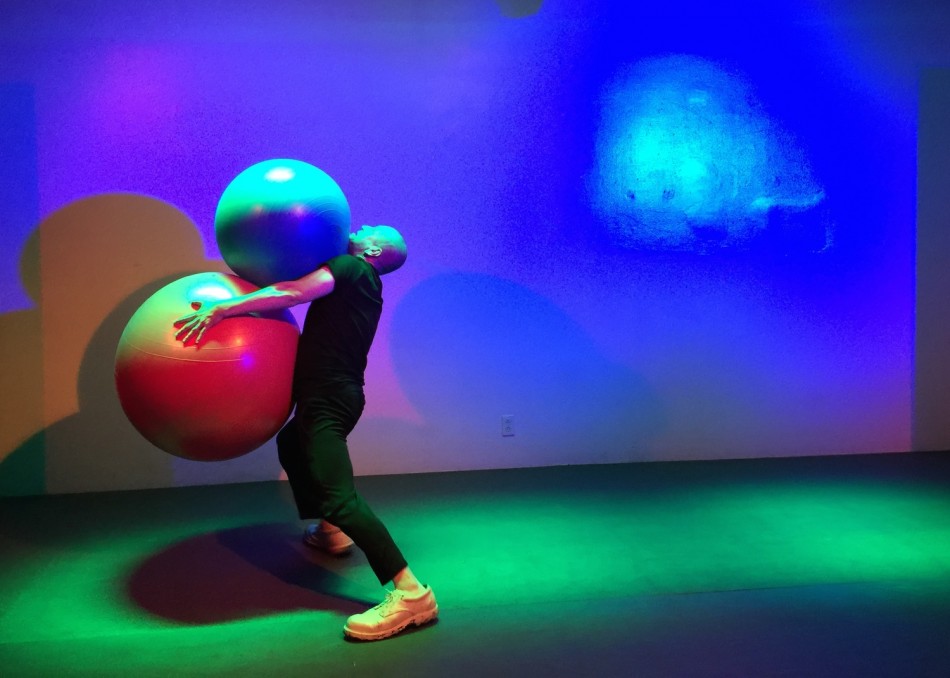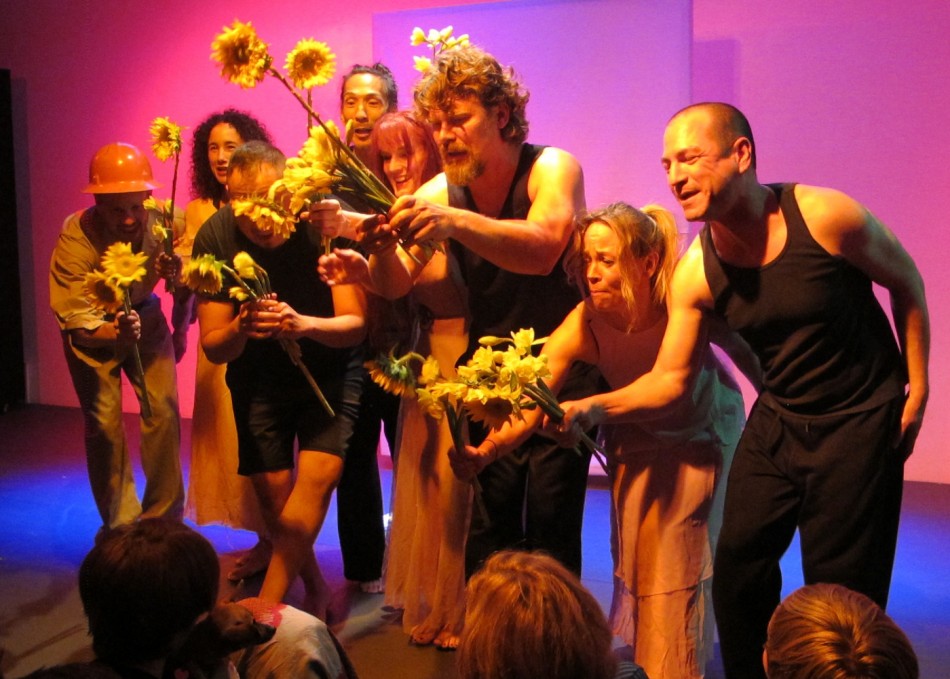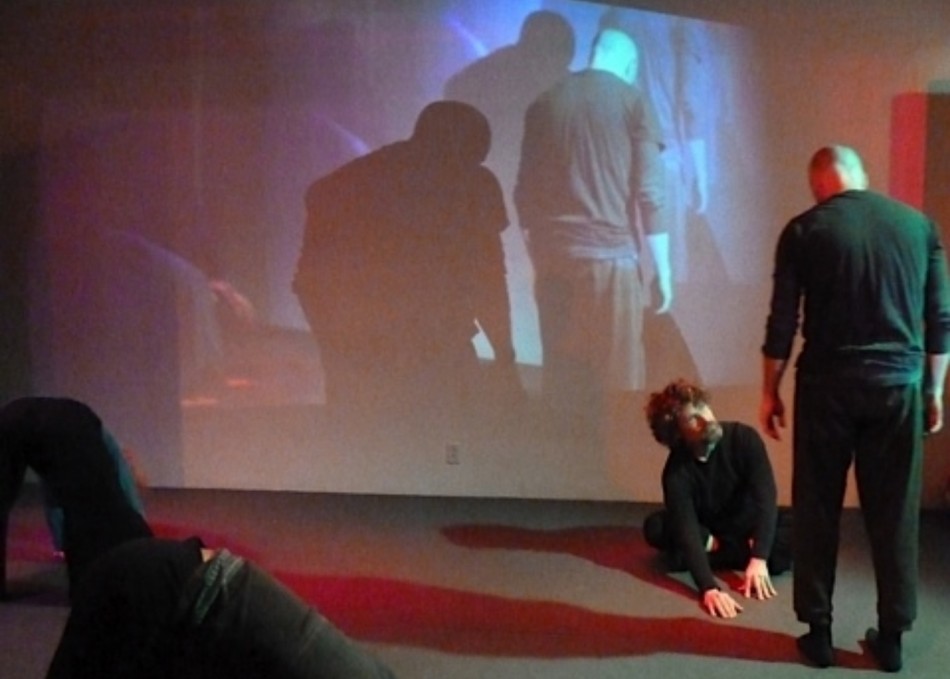
Rachel Rosenthal. Portrait by Michael Childers
Improvising Rachel Rosenthal, Always Avant-Garde
The contemporary art world’s performance fervor and cross-pollination of artistic media are a throwback to the late 1950’s when visual and performing artists began to liberate from the strict confines of Modernism. Performance and theater artist Rachel Rosenthal was an early member of Merce Cunningham’s New York dance company and befriended artists Jasper Johns and Robert Rauschenberg. Rosenthal and Rauschenberg exchanged ideas that would influence their life and work for many years.
In 1955 Rachel Rosenthal moved to Los Angeles where she embarked on a new form of improvisational theater called Instant Theater, while Robert Rauschenberg took over the lease on her Greenwich Village apartment and employed traditional performance conventions to concepts already understood in his visual art practice.
“Pelican” performed by Robert Rauschenberg and Cunningham dance company member, Carol Brown in 1963. (Video link here or click on the frame at right.)
Rachel Rosenthal, born in Paris in 1926, is now 88. Her latest embodiment is the artistic director of a theatrical company called, TOHUBOHU!, described as “Total Free Improvisation,” ensuing in performances which cannot be scripted, repeated, or rehearsed in the same way that a typical theatrical production can.
Rosenthal, however, describes the history of her work in improvisation as having similarities to performance art, but says, “I was always far more theatrical in my approach.”
A 1985 feminist review described one such performance in which the artist, dressed in camouflage pants and black t-shirt, screamed in French at the audience while air-raid sirens wailed. In 1989, Rachel Rosenthal founded the Rachel Rosenthal Company with a mission of “communicating relevant social, environmental, cultural, gender, and spiritual issues to a broad public” as the company “(redefines) the boundaries of theater.”
I interviewed Rachel Rosenthal in Los Angeles.
Audrey Rubinstein: You are one of the few artists I know who is as committed to your personal transformation as your art. What questions are you contemplating?
My whole life has been connected to my work, my art. The subject I best understand is me, but I have changed radically over the years. I am not religious, and only mildly spiritual. I’m a person living in a world, which is dynamic and full of mystery. I’m always checking to see my connection to the planet, to other species, to the world at large. I basically have no family so I don’t have that to worry about, and though I have had my financial ups and downs, I’ve been fortunate to be able to focus fully on these issues. I’m very concerned with our botched relationship to the earth. I worry about the earth and its creatures more than I do for our species and its political dances. I’m convinced that we are heading for either a total downfall of civilization or a radical transformation.
I am old and might not live long enough to experience the outcome of this transformation, but I can see the process beginning and I’m not optimistic. I see calamities happening all the time and everywhere, both man-made and planetary.
Tell me about TOHUBOHU!, the company, the work.
My company is my current connection to the art world. We perform a form I call TOHUBOHU! It’s really a French word adopted from the ancient Hebrew that roughly translates as collision, chaos and hubbub. It is not a description of what we do, but what we have to pass through in order to achieve the kind of theater we’ve created, which in my opinion is unique. TOHUBOHU! Is really a question of research into what constitutes a theatrical statement, which is presented as a final product, but is never repeated, so that it is really part of a process of creativity. We have worked together as a group—some of us for decades—to learn how to co-create art pieces in the moment that represent what we believe to be true are truly works of art. After many years of working together, we have reached a point of achievement that makes me proud. My other connections with the art world have shrunk due to my various disabilities, but I’m still able to lead my company on the aesthetic path I consider important.
How does TOHUBOHU! relate to Instant Theater —the work you and your ex-husband King Moody began in the 1960s?
Instant Theatre is the ancestor of TOHUBOHU! It led to and was the birth of my brand of total improvisation. It has been varied in its components, dictated by the assorted student bodies that came and went through the years. When I was still able to move well, I participated in the improvisations. When I moved less adequately, I developed 25 years worth of solo work. When I went back to working with a group of my students in the ‘90s I carried my interest in language to the company. That said, the work the company does now is primarily non-verbal. I’ve always believed in instinct and intuition, and based my teaching on that premise.
What was your connection to Robert Rauschenberg (the Pop Art painter whose collaborative performances at Black Mountain College with John Cage and Merce Cunningham were some of the earliest performance art manifestations?)
I first met Bob in NYC. I had become naturalized American after being a French refugee in Brazil. I was hopping between NYC and Paris for eight years. One of the years I was in New York, Bob had entered the entourage of John Cage, and since I was part of that group, I was able to add Bob to my list of friends. When he and Jasper Johns became friendly, Jasper also joined the entourage, and a bunch of other artists, musicians and poets. I was lucky and grateful to be a part of that group.
Bob was a maverick, and his chutzpah amazed me. His way of transforming abstract expressionism into his own form set me off on a new path. Bob experimented with “Performance Art” while he was at Black Mountain, and I’m sure that that influenced me from afar. Bob was fearless, and he entered the art world with great fanfare. Sitting in a hammock in my loft, he would sound off on his theories, and I tried to absorb them. A lot of what he said was obscure and over my head, but entered my subconscious.
Who were your biggest artistic and personal influences?
There are many and they’re a heady mix. It starts with my father in childhood, who was a lover of the Italian Renaissance. A teacher at the High School of Music and Art (NYC), Mrs. Rosen opened my eyes to (Cubist painters) Picasso, Braque, Klee, etc. Having lived my early days in both Paris and New York, I used both as sources and became very familiar with French theatre as well as contemporary American painting. I have had many teachers—a list too long to enumerate. The strongest impression which informed my world combined art and everyday life on both continents. Antonin Artaud was a big influence, and in New York, John Cage, Rauschenberg, Merce Cunningham, Cy Twombly, Jasper Johns. When I finally left New York and came to Los Angeles in 1955, I began to experience who I was as an artist, in a continuation of these influences carried with me all my life. Suffice it to say I was a sponge, and was lucky enough to have the leisure to transform influence into object.
TOHUBOHU!’s performs at ESPACE DBD/RACHEL ROSENTHAL COMPANY
2847 S. Robertson Blvd., LA, CA 90034-2439
For performance dates call (310) 839-0661 or check out rachelrosenthal.org

TOHUBOHU! performance image

TOHUBOHU! performance image

TOHUBOHU! performance image

